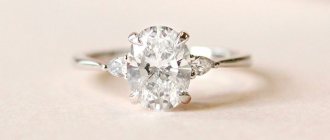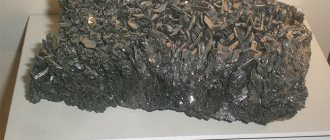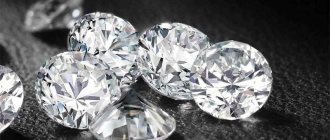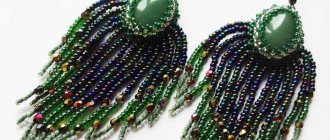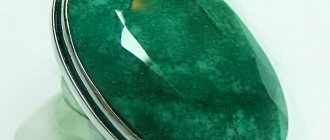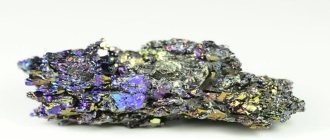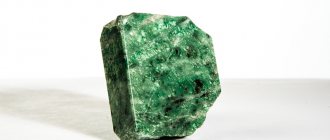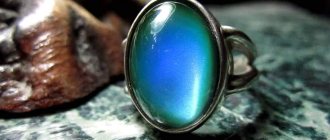Origin story
The stone is named after its discoverer, Henri Moissan. He explored the area of the meteorite fall in the US state of Arizona in 1893. In the cosmic body, the scientist found plates of moissanite, previously unknown in mineralogy.
Interestingly, long before the discovery in the 20s of the 19th century, a similar chemical material was obtained by Jacob Berzelius . The scientist proposed using the durable mineral for technical purposes for spraying tools and grinding stones. But the invention was underestimated and not recognized.
Later, the stone began to be found in other fragments of meteorites, but they could not be processed. The small number of specimens did not allow finding a field of application for the new mineral.
But soon silicon carbide powder (the chemical basis of moissanite) was created in the laboratory by Edward Acheson . He owns a patent for an artificial analogue of moissanite - carborundum, and for a special furnace for its processing, which is still used today.
Nowadays, stones for jewelry - moissanite - are made from powdered silicon carbide.
Moissanite: General Information
Moissanite is a very rare space rock named after its discoverer, Nobel Prize winner Henry Moissanite. It was this man who, at the beginning of the 20th century, found a small amount of silicon carbide crystals and discovered that these were not ordinary fragments, but almost precious stones.
Characteristics of the stone
Moissanite is considered one of the rarest varieties of silicon carbide. For some time it was even classified as one of the types of diamond due to similar characteristics, but this opinion was incorrect. In 1905, scientists carried out all the necessary research. Then they found out that this stone has nothing to do with diamond , since the latter “appeared” on the basis of carbon. Although they have a similar crystal lattice, they differ in the range of colors.
Meteorite stones are found quite rarely in nature. Over this long period of time, scientists were able to find only a few handfuls of small pebbles. They were found either in the upper layers of the earth, or inside the same diamonds, which made the study of the stone called moissanite even more difficult. Why can’t larger deposits be found and what kind of stone is moissanite? This has been a mystery for several centuries. And experts found the only correct solution - several centuries later, scientists from the Russian Academy of Sciences laboratory created the world's first large, high-quality jewelry moissanite.
The most beautiful and brightest stone in the world
Most likely, moissanite is not very well known to the average person. It must be assumed that every ignorant person, if asked: “Which gem is the most beautiful and brightest in the world?” - he will say: “Diamond.” However, this is absolutely not true. The cosmic mineral is hundreds of times brighter and more brilliant than a diamond . The whole point is that consumers do not yet see this stone as a leader. What kind of stone moissanite is, they just have to find out. Because in reality, in terms of the totality of all these qualities, this stone will very quickly overtake a diamond.
A stone that looks like an “idol” was created by man at the behest from heaven! Moissanite compares favorably with other minerals, both in its brilliance and beauty. Connoisseurs have long considered moissanite to be the “crown of creation”! Since it can satisfy any, even the most capricious collector and jeweler. This stone is so pure that it is almost 100% superior to any diamond on earth. It is slightly inferior to diamond only in hardness. Although it is much stronger than diamond .
This is the paradox. This feature made moissanite even more practical. Due to all these advantages, the stone quickly conquered the entire jewelry market in the world. And you have to think that this is just the beginning.
Moissanite and cubic zirconia
Real moissanite is a very durable stone with a diamond or metallic luster . For example, its hardness on the Mohs scale is 9.25.
For comparison: a diamond has 10. In a meteorite, the mineral does not exceed 3 mm in size, and is capable of melting only at 2800 °C. This description allows you to compare moissanite with a diamond and its imitations, such as cubic zirconia.
What is cubic zirconia
Cubic zirconia is an artificial stone not found in nature. It consists of zirconium oxide and non-ferrous metal oxides, which color the mineral in various shades. Colorless cubic zirconia imitates a diamond, and colored cubic zirconia imitates other precious stones .
Cubic zirconia is quite hard (8 on the Mohs scale) and heavy (density 10 g/cm3). The cost of cubic zirconia is very low compared to natural minerals, which explains its widespread use in jewelry.
Carborundum and cubic zirconia
Although both stones are created to imitate a diamond and are of synthetic origin, their properties differ significantly :
- Cubic zirconia is easier to scratch, but only diamond can damage moissanite.
- The refractive index of carborundum is higher, which means that more rays are reflected from it and creates “diamond” shimmer. Cubic zirconia crystals transmit most of the light through themselves.
- High strength makes it possible to make the edges of carborundum clear, while in cubic zirconia they initially or over time become rounded. Scratches, chips or cracks may appear on cubic zirconia jewelry while worn.
How to distinguish
It is not difficult to distinguish cubic zirconia in jewelry with the naked eye : its shine will be much less than that of moissanite. The beveled edges of cubic zirconia can be examined under a magnifying glass.
Jewelers can easily distinguish these stones by their thermal conductivity using a diamond tester. It defines carborundum as a diamond.
View this post on Instagram
Posted by JEWELERY WORKSHOP (@polarstr) Oct 8, 2021 at 11:48 am PDT
An artificial diamond - moissanite - will not retain traces when touched with fingers. When heated under a candle flame, carborundum begins to emit a green spectrum of light. Under an ultraviolet lamp, red and orange rays predominate .
Advice! In a specialized store, before purchasing, at the client’s request, they can show a certificate with the name of the stone, its cutting method, weight and manufacturer.
What is moissanite
This is the name of a synthetic mineral obtained in laboratory conditions. Essentially, this is a crystal grown from silicon carbide. It has the same properties and appearance as diamond material, but still differs in some characteristics. It is impossible to distinguish it from a real pebble with the naked eye, so the use of specialized equipment is necessary.
This material was first submitted to gemologists for consideration in 1996 in the city of Tucson. He immediately attracted the attention of many scientists and they began to study him closely.
It is interesting that not all methods popular at that time made it possible to identify a fake. For example, by measuring the thermal conductivity of a mineral, it was possible to easily distinguish diamond from its analogue, strontium titanate, cubic zirconia, or synthetic sapphire. But with moissanite, everything is much more complicated: thermal conductivity tests did not give results - they identify it as a diamond. That is why alternative methods of determining the authenticity of stones were required.
Carborundum – artificial moissanite
Carborundum has become practically the only way to use the properties of moissanite for making jewelry. A natural mineral is too rare a find , which is practically impossible to process due to its small size and lamellar structure.
The invention of carborundum made it possible to produce large stones similar to diamonds in external and physical properties.
For the first time, the American campaign CREE attempted to create an analogue of a diamond from artificial moissanite. In 1987, large samples of moissanite were created on an industrial scale. Since 1995, diamond cutting has been tried on them, and the reviews from jewelers were enthusiastic.
Moissanite in jewelry
The popularity of moissanite (carborundum) in the jewelry industry is understandable: in some characteristics the stone is even superior to a diamond .
The only drawback that does not allow replacing the precious mineral completely is its artificial origin.
View this post on Instagram
Publication from CUSTOM JEWELRY (@uvelir_moskva) Sep 30, 2019 at 1:15 PDT
Knowing how to distinguish moissanite from a diamond, you will not fall for the tricks of unscrupulous jewelers:
- Moissanite shimmers in the light with darker highlights than a diamond.
- The refractive index of carborundum is higher than that of a precious stone, and it reflects rays 20% more and shimmers.
- Moissanite does not fade when touched by fingers, unlike diamonds.
- Under a magnifying glass, the polishing lines of the edges are visible: in moissanite they are parallel to each other, while in precious stone they are in different directions. The edges of the edges of the artificial stone bifurcate from the inside.
- Finally, each gemstone has a certificate of quality with its name and main characteristics.
What does the cost depend on?
The price of a product with moissanite depends on the same indicators as other minerals:
- weight;
- color;
- processing method;
- cost of precious metal;
- production and delivery costs.
Moreover, the last point plays an important role - expensive equipment is used during production and a lot of electricity is spent . In terms of cost, moissanite is comparable to a high-quality artificial diamond.
View this post on Instagram
Posted by Moissanite Manufacturer-Vivian (@moissanite_factory) Oct 1, 2021 at 9:48 am PDT
What goes with it?
Moissanite can be combined with any precious metal. Moissanite is neutral in relation to other stones and can be used to realize any design ideas.
The main thing, like a diamond, is not to combine it with ornamental stones.
What jewelry does he look best in?
Jewelry with moissanite reveals its beauty to the fullest in jewelry:
- long earrings or studs;
- engagement or wedding rings;
- pendant on a short gold chain.
View this post on Instagram
Posted by Moissanite/Products/Jewelry (@moissanite_paradise) Mar 7, 2021 at 12:50 PST
It is appropriate to wear jewelry for the bride , for special events, dinner in a restaurant.
Men can also wear jewelry with moissanite in the form of a ring or cufflinks.
How to distinguish?
We have already said above that it is not possible to differentiate these two stones independently. But special methods with which differences can be identified have, of course, been developed.
And if it is really important to you which stone sparkles in the jewelry, the information below may be useful. Next, we will briefly talk about the most popular methods among jewelry makers that allow them to differentiate moissanite and diamond.
Optical tests. The optical testing technique involves examining the product under a special jewelry microscope.
Only with the help of powerful magnifying optics is it possible to capture such differences as:
- cleavage of edges;
- ghosting effect;
- scintillation.
Moissanite is distinguished by less sharp cleavage of its facets, fixation of the ghosting effect (this is not typical for a diamond), as well as color scintillation. The latter, in turn, is due to significantly higher refractive index, as well as light dispersion.
Open flame technique. This test is quite simple and can be done at home. But at the same time, it is always worth remembering the high probability of damage to the jewelry. The essence of the technique is as follows: the stone is brought extremely close to the flame (for example, a match) and changes in color properties are observed for 20-30 seconds. It is characteristic that moissanites turn green, while diamonds do not change shades of their original color.
Important! Repeated and/or prolonged exposure to flame can lead to clouding, darkening of the stone, as well as the appearance of a specific greenish coating.
Ultraviolet test. Currently, this is the most expensive differentiation method, as it requires the use of special equipment. The device emits ultraviolet light and, at the same time, records the intensity of its absorption by the stone being tested. Thus, it was found that diamonds transmit ultraviolet radiation, while moissanites absorb ultraviolet radiation.
Unfortunately, the data produced by an expensive device may contain errors. After all, some diamonds have strong fluorescent properties while absorbing ultraviolet radiation. In addition, the smallest pebbles are not amenable to this testing option.
Electrical conductivity test. To carry out such a differentiation test you will also need a special device. Testers have a clamp that holds the test sample, conducts impulses and, at the same time, captures their conductivity. Thus, it was found that all variants of moissanite studied to date have more or less pronounced electrical conductivity properties.
As you can see, effective differentiation methods require special equipment and, of course, a number of skills. And if the question about the nature of the jewelry is of considerable importance to you, then it is better to contact the appropriate specialist in order to get the correct answer.
Knowing about the testing methods used, you will be well-versed and will be able to understand the conclusion issued by the jeweler, without getting confused and not missing important points for you.
Moissanite price per 1 carat
The price of 1 carat of cut stone without color reaches $300. Green copies are 30% cheaper, and yellow and brown ones are almost 2 times less. It is not economically feasible to produce small moissanite stones up to 2 mm: they cost almost the same as natural diamonds.
The cost of jewelry with colorless moissanite weighing 0.1 carats starts from 10 thousand rubles. (ring or earrings) .
How to distinguish moissanite from diamond
One of the optical tests to distinguish Charles & Colvard moissanite from a diamond
The magnificent “game” of moissanite was appreciated by many fans of precious items. The stone turned out to be a real find for the jewelry industry.
With characteristics that are not inferior to diamonds, the cost of moissanite is significantly lower than its older brother, and is approximately $400–600 per 1 carat versus a diamond carat costing $6,000–$10,000.
However, the stone born in the laboratory became not only a sensation, but also a headache. After all, it is very difficult to distinguish moissanite from a diamond. Although, there are still some features that allow you to find out who is who.
The healing properties of moissanite
Despite the synthetic origin of carborundum, lithotherapists endow it with healing properties. Moreover, not only contact with the stone, but also its frequent contemplation can have an effect. The positive effect occurs at the subconscious level due to improved transmission of nerve impulses in certain parts of the brain.
Recommended for:
The stone can be recommended for people suffering from memory impairment, nervous system lability, and loss of vitality.
Important! The stone is unable to cure serious somatic diseases without traditional treatment.
What ailments does it relieve?
By improving the activity of the areas of the brain responsible for the perception of pain, you can get rid of migraines and chronic spasms of the digestive system .
Moissanite will help get rid of the effects of severe stress, depression and other mental disorders.
Interestingly, black moissanite is considered a universal healer : it has a positive effect on the entire body.
Price
The price is set at approximately 5-10% of the cost of a diamond of identical quality. But don't delude yourself. Moissanite imitates expensive pure diamonds, so the average price is $250 - $600 US. A ring with moissanite costs approximately 40,000 rubles.
For comparison: a cubic zirconia insert costs 40 - 50 rubles. The cost of the product mainly depends on the weight and quality of the frame.
For this reason, it did not become a mass stone. Few people will want to buy a product with synthetic inserts for a lot of money. Even though this stone is very beautiful and shiny, it is an imitation.
Magical effect on human destiny
A synthetic stone can only exert magical effects after being recharged.
Does hydrothermal moissanite work?
Newly purchased moissanite is charged with fiery energy from the sun. The stone should be taken outside or placed near an open window under the rays of the rising sun.
You can clean in the afternoon, when the sun begins to descend from its zenith.
What areas of life does it improve?
Moissanite or carborundum will help you develop your best qualities and attract financial wealth. The crystal interacts with human chakras and brings harmony of energy to each of them. With constant interaction with the stone, the financial sphere of life and relationships with others will improve due to changes in the emotional background. Moissanite increases self-esteem, confidence in the success of new endeavors and helps in the fight against fears.
View this post on Instagram
Posted by Moissanite Manufacturer-Vivian (@moissanite_factory) Oct 1, 2021 at 9:31 am PDT
Who is moissanite suitable for?
You can try to correct the following qualities with the help of moissanite:
- desire to do everything perfectly (perfectionism);
- excessive control over the lives of others;
- excessive emotionality and sensitivity.
The mineral is suitable for people in public professions who need a feeling of self-confidence and improved speaking abilities.
Stone according to zodiac sign
Astrologers classify the stone as a fire element. Therefore, he will best help Aries and Leo . For air signs of the zodiac, the stone will help improve their emotional state. Pisces, Virgos, Capricorns, and Taurus can wear moissanite as a protective amulet .
Production of synthetic moissanite
A patent for the synthesis of moissanite by sublimation was received only in 1998 in America. The formation of a colorless crystal takes a long time and requires a lot of energy.
Jewelry with moissanite is in demand , but only a few jewelry companies around the world are engaged in the synthesis of stones. The largest of them is CharlesColvard with several branches in European countries. The formation of moissanite occurs at a temperature of 1500 ° C and a pressure of 500 thousand bar.
Jewelry with moissanite is rarely found in jewelry stores; in most cases, they are made to order.
Artificial diamond, cubic zirconia, Swarovski crystals
In recent decades, technologies for the artificial cultivation of precious stones and their analogues have been actively developing. Of course, most of all, manufacturers, jewelers, and buyers are interested in the possibilities of producing the king of precious stones - diamond, which is due to its price. The high price of natural diamonds is associated, first of all, with their properties, such as phenomenal hardness, excellent ability to refract and return light, which ensures the sparkle and play of a cut diamond. But there is another important factor - significant monopolization and closure of the diamond mining market, which does not allow the price of stones to fall according to the natural market laws of competition.
Recently, laboratories have developed several technologies for growing synthetic diamond, the most common two of them:
- In a chamber at high pressure (50-60 kilobars) and temperature (about 1400-1600 degrees Celsius), which has the abbreviation HPHT (High Pressure, High Temperature), growing an artificial diamond of about 1 carat using this technology takes about 5 days.
- Chemical deposition (CVD). The most popular variation of this process is microwave plasma vapor deposition (MPCVD), using a mixture of methane and hydrogen gases as the starting material.
Manufactured artificial diamonds have a number of disadvantages:
| The lowest prices for moissanite in Russia |
- The main drawback is the color. It is quite easy to synthesize richly colored stones (yellow, blue, green, pink, etc.), but the problem of producing perfectly colorless diamonds still remains unsolved. A standard artificial diamond has an IK color on the GIA scale, which corresponds to color 6-7 according to the Russian TU standard. This means that the synthetic diamond has a clearly visible yellowish tint. Recent advances in HPHT and CVD technologies have made it possible to obtain GH color, i.e. 4-5 color according to specifications, but the complexity of production does not yet allow the prices of such stones to drop significantly below the prices of natural diamonds of similar characteristics.
- Foreign matter, metallic for HPHT and black strands of unconverted carbon for CVD.
- Presence of metal impurities for HPHT; nitrogen, silicon and hydrogen for CVD - which allows you to easily identify the synthesized stones by spectrogram.
- Presence of characteristic fluorescence.
Despite the noted disadvantages, modern high-quality synthetic diamonds are difficult to distinguish from natural ones even by an expert in a jewelry store or pawnshop; only a laboratory can do this. The main disadvantage of artificial diamonds remains their high price, comparable to natural stones of the same quality.
| Synthetic diamond | |
| Advantages | Flaws |
|
|
A very common misconception is that cubic zirconia is a synthetic diamond. This is fundamentally wrong; a synthetic diamond is no different in composition from its natural counterpart, that is, it is a carbon crystal. Cubic zirconia is a cubic crystal of zirconium dioxide, synthesized for the first time by the Lebedev Physical Institute; it is often confused with the natural stone zircon, which, in turn, is a crystal of zirconium silicate. Cubic zirconia has two significant disadvantages:
- Low hardness, due to which it loses its shine, scratches and chips.
- The relatively low refractive index is why light can often be seen through cut cubic zirconia, which gives the feeling that you are holding a glass fake in your hands. A well-cut diamond or moissanite does not allow light to pass through, allowing for complete internal reflection of light.
Cubic zirconia is currently a very cheap stone, the market price of which is about $50 per kilogram, i.e. less than half a ruble per carat. Thanks to this fact, cubic zirconia is very beneficial to insert into various jewelry and decorate clothes with it. Some unscrupulous sellers confuse buyers by calling cubic zirconia Brillianite and other misleading names, while unjustifiably raising prices for jewelry with them. Buying gold jewelry with cubic zirconia is not very wise because of the low service life of cubic zirconia, which noticeably fades in 1-2 years due to micro-scratches and abrasions. However, the new well-cut cubic zirconia is quite close to a diamond in its jewelry properties, i.e. capable of delivering impressive sparkle and play.
| cubic zirconia | |
| Advantages | Flaws |
|
|
Nevertheless, cubic zirconia in its sparkle and play compares favorably with Swarovski crystals, which are crystal, i.e. glass with the addition of lead oxide. The addition of lead allows them to achieve some shine and play, but they are very far from being a diamond or even cubic zirconia. Daniel Swarovski's genius was to put a backing of aluminum foil under a penny crystal rhinestone, which would reflect the light "flowing" through the crystal, making it appear brighter. Neither a diamond, nor, especially, moissanite need such tricks, because... Being well cut, they return all incoming light back up into the observer's eyes, giving them outstanding brightness and brilliance.
| Swarovski crystals | |
| Advantages | Flaws |
|
|
| Products with American quality moissanite |
Moissanite has become popular in recent years as a new gemstone that is very similar to diamond. This stone is a silicon carbide crystal first discovered by French chemist Henri Moissan in 1893, which was named after him in 1905. In its natural form, moissanite occurs in very small grains and in meteorite matter. Several years ago, the American company Charles & Colvard patented a method for producing synthetic gem-quality moissanite. Moissanite is most notable for its superior refractive index and dispersion properties to diamond, allowing it to sparkle and sparkle more than diamond. In addition, it is practically not inferior to diamond in hardness, i.e. does not scratch or fade, unlike cubic zirconia.
It is worth noting that two polytypes of silicon carbide crystals are common. One of them (6H-SiC) exhibits yellow fluorescence (glow when exposed to ultraviolet rays), which makes the stone yellowish and cloudy in sunlight. The other one (4H-SiC), which recently went on sale, has no fluorescence and is indistinguishable from diamond in this property. In addition, moissanite has physical properties, such as density and thermal conductivity, very close to diamond, so often even the latest generation portable testers (Presidium Multitester III) mistake high-quality moissanite for a diamond.
| New generation moissanite 4H-SiC (left) and old generation 6H-SiC (right) in natural light |
In addition to its optical properties, an important advantage of moissanite is its price. With a similar stone size, the price of moissanite will be an order of magnitude lower than both natural and synthetic diamonds. In addition, moissanite can be made to almost any size, unlike synthetic diamonds, the weight of which is currently limited to about 2-3 carats.
We hope that our article will help you make the right choice of stone to set in your jewelry.
| Moissanite | |
| Advantages | Flaws |
|
|
We invite you to visit the widest catalog of jewelry with moissanites in Russia on the website of our online store Bright Spark. In our articles you can learn more about the properties of moissanite and a comparative analysis of prices.
